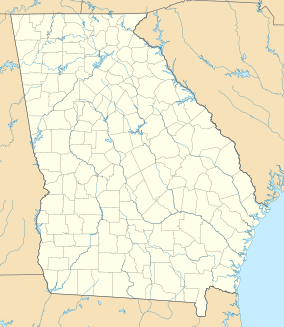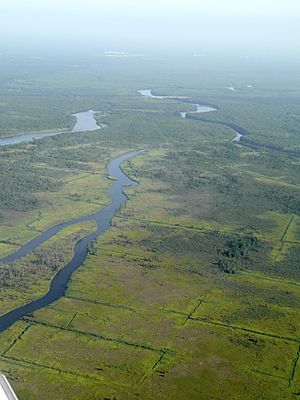Savannah National Wildlife Refuge facts for kids
Quick facts for kids Savannah National Wildlife Refuge |
|
|---|---|
|
IUCN Category IV (Habitat/Species Management Area)
|
|
| Location | Georgia and South Carolina, United States |
| Nearest city | Savannah, Georgia |
| Area | 29,175 acres (118.07 km2) |
| Established | 1927 |
| Visitors | 130,000 (in 2004) |
| Governing body | U.S. Fish and Wildlife Service |
| Website | Savannah National Wildlife Refuge |
The Savannah National Wildlife Refuge is a huge natural area in Georgia and South Carolina. It covers about 31,551 acres, which is like 128 square kilometers! This special place was created to protect birds that travel long distances. It also helps keep nature and forests safe for everyone to enjoy.
The refuge is managed by the U.S. Fish and Wildlife Service. It is part of a bigger group of seven refuges called the Savannah Coastal Refuges Complex. This team works hard to protect wildlife and their homes.
Contents
History of the Refuge
People have lived in the Savannah, Georgia area for a very long time. The first Europeans arrived here in 1526. Later, in 1733, James Oglethorpe started the city of Savannah.
Long ago, in the 1700s, farmers grew rice on much of this land. They built special walls called levees by hand to control water for their rice fields. These old levees are still used today as part of the refuge's water system. You can even see parts of the old water gates and narrow walls in some places.
The Savannah National Wildlife Refuge was officially started on April 6, 1927. It was first called the Savannah River Bird Refuge. It began as a smaller area of about 2,352 acres. This was a safe place for native birds to live and raise their young.
Over the years, the refuge grew bigger. In 1931, it was renamed the Savannah River Wildlife Refuge. More land was added in 1936. Finally, in 1940, it got its current name: the Savannah National Wildlife Refuge. Many different pieces of land have been added over time. Today, the refuge is about 29,174 acres in size.
What the Land Looks Like
The refuge is in a special area called the Lowcountry. This is a flat area near the Atlantic Ocean. It has sandy hills on one side and the ocean on the other.
Inside the refuge, there are about 38 miles of river. There are also over 25 miles of smaller streams and creeks. The land here has different types of habitats. These include forests near rivers, swamps, and wetlands that are affected by tides.
About 3,000 acres of the refuge are "managed freshwater impoundments." These are like big ponds or lakes where water levels are controlled. They are important for many animals.
Animals and Plants
The Savannah National Wildlife Refuge is full of life! It has many different plants, especially in the warm summer months. It's also home to a wide variety of animals.
Many birds visit the refuge because it's on the Atlantic Flyway. This is like a superhighway in the sky for birds traveling between their summer and winter homes. In winter, thousands of ducks, like mallards and pintails, come here. They join the wood ducks that live here all year. In spring and fall, songbirds stop to rest during their long journeys.
You can see many types of wildlife here, including:
- Ducks and geese
- Wading birds (like herons)
- Shorebirds
The refuge also protects several special animals. These are species that are threatened or endangered, meaning they need help to survive. Some of these include:
- The American alligator
- The flatwoods salamander
- The bald eagle
- The wood stork
- The shortnose sturgeon (a type of fish)
- The Florida manatee (a gentle sea mammal)
The refuge is also a nesting place for birds like wood ducks, great horned owls, osprey, and swallow-tailed kites.
Things to Do and See
The Savannah National Wildlife Refuge has a visitor center in South Carolina. It opened in 2010 and is a great place to start your visit. Inside, you can see exhibits about the refuge's history and the animals that live there. There's also a short video and a nature store. The visitor center is open Monday through Saturday.
There are many ways to explore the refuge:
- Hiking: You can walk on the dikes (the old rice field walls) and other trails. These are great spots to watch for wildlife.
- Cycling: You can ride your bike on some paths.
- Photography: Bring your camera! There are amazing opportunities to take pictures of nature and animals.
- Wildlife Observation: This is one of the best things to do! Look for birds, alligators, and other creatures.
Remember, pets are not allowed in the refuge.
A popular way to see the refuge is the Laurel Hill Wildlife Drive. This is a 4.5-mile loop that you drive slowly. It takes you through freshwater pools and forests. These pools and dikes are leftovers from the old rice plantations before the Civil War.
If you like to fish, you can fish in the freshwater pools from March 1 to November 30. You need to follow the rules from South Carolina and the refuge. The refuge also has some hunting seasons in the fall and winter. You can find more information about these at the Visitor Center or on their website.
How to Help: Volunteer Opportunities
Volunteers are very important at the Savannah National Wildlife Refuge! They help keep the refuge running smoothly and make it even better.
If you want to help, you could:
- Work at the information desk at the Visitor Center.
- Help remove plants that don't belong there.
- Pick up trash and help with other cleaning tasks.
- Join in activities that help manage the wildlife.
- Speak up for the refuges to government groups.
If you are interested in volunteering, you can contact the Friends of the Savannah Coastal Wildlife Refuges. They can tell you more about how to get involved.



